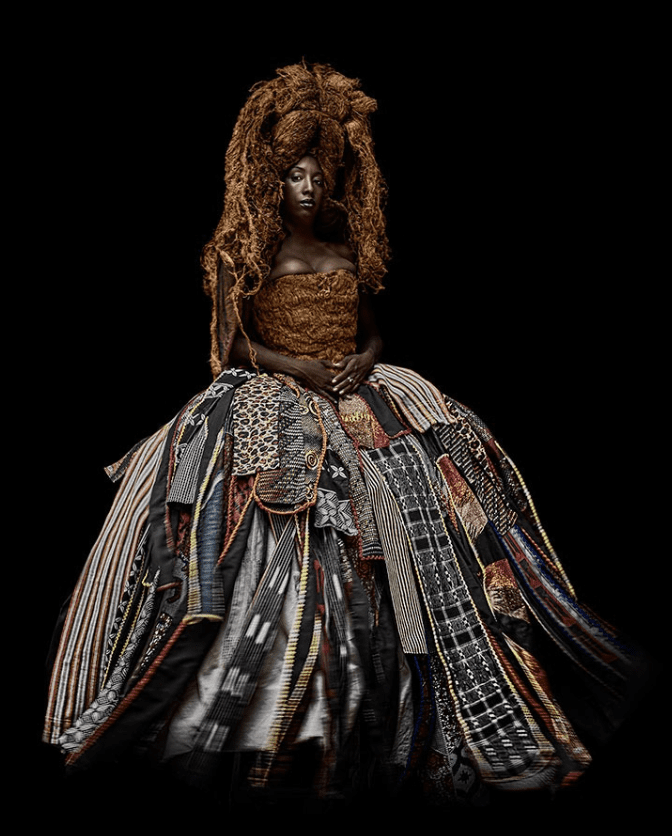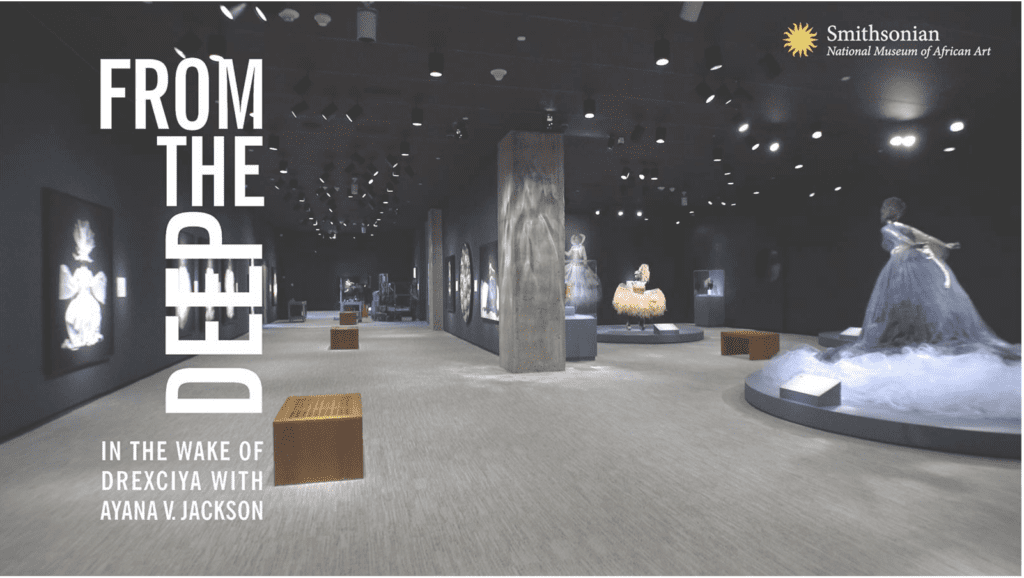‘From the Deep’: Afrofuturistic Aquatopia at African Art Museum
By • May 18, 2023 0 1667

The artist Ayana V. Jackson is very much part of “From the Deep: In the Wake of Drexciya with Ayana V. Jackson,” the exhibit she created now at the Smithsonian Institution’s National Museum of African Art until April 2024.
Drexciya is a myth of an aquatopia in the Atlantic Ocean populated by the children of enslaved African women who were thrown overboard or jumped from slaving ships during the Middle Passage. Created by James Stinson and Gerald Donald, the Detroit electro duo Drexciya, in their 1992 album “Deep Sea Dweller, it’s “a world of vengeful warriors.” The exhibit is curated by Karen E. Milbourne, PhD.

Courtesy Smithsonian Museum of African Art.
Jackson, who learned about mythical sea creatures such as Neptune in school, has a different vision of this imaginary Afrofuturistic world, one with mothers and spirits, and one inspired by the late writer and critic Greg Tate who described Drexciya as a “revisionist look at the Middle Passage as a realm of possibility and not annihilation.”
Jackson is a noted photographer who’s re-created this watery world in a stunning exhibit of photographs, videos and sculptural representations, accompanied by readings, sound and scents. She’s very much a part of the exhibit, as she’s the model in a gallery of photographs that introduces the spirit figures in the story: Cleansing (“It Is Only When You Lose Your Mother That She Becomes Myth”), memory (“The Self-Forgetfulness of Belonging Will Never Be Mine”), diversion (“I Summon the Voice from the Deep I “), buoyancy (“Cascading Celestial Giants”), atonement (“When the Spirit of Kalunda Comes So Does Kianda”), retrieval and recovery (“The Rupture Was the Story”), creation (“Where There Is Origin but No Memory II,” and “I Summon the Voice from the Deep.”) There’s a spirit we encounter in motion and stop-motion projection within “Reckoning: Consider the Sky and the Sea.”
Jackson’s research for the exhibit was extensive, not only to recreate this story but to represent what Drexciyans might have worn in 16th-century Elizabethan times. She traveled extensively to Senegal, Ghana, Angola, Trinidad and Tobago, and South Africa, researched museum archives for photographs of Nigerian and Angolan ceremonies. She delved into textile collections to recreate this watery world of fabrics and fashions that would be eye-stopping at the Met Gala. She collaborated with fashion designers: Rama Diaw of Senegal, Olabangi “Chedder” Arowoshola of Lagos, Mwambi Wassaki of Angola, and Robert Young of Trinidad and Tobago.
The attire is made of a variety of materials that might wash up in ocean trash — a voluminous skirt formed from shredded plastic bags, a bodice of stray spoons, head gear, gowns and accessories, exquisite hand-stitched bodice, rusting crown, intricately woven wig, and unsettling collar. Displayed in a separate gallery, these items taken out of the context as presented in photographs, gives pause as to how we view objects in a museum from another time and place. What the exhibit presents is the myth Dxeciya, while the harsh fate of Africans on Middle Passage slave ships over the Atlantic was reality.
One particular photographic portrait most powerfully captures this connection between what we see on the walls of an art gallery when separated and displayed in a museum case. “Reliquary: The Sea Has Nothing to Give but a Well-Executed Grave” which represents greed, the underlying motives of the slave traders, through beads traded for lives, and a skirt bundled by bones of the dead, is an adornment separated from its context as it is displayed in a case. Stunning in beauty and inspiring wonder, the exhibit “From the Deep: In the Wake of Drexciya with Ayana V. Jackson” does not shy away from what was brutal and horrifying in the fate of enslaved Africans. It does what art can do and turns the lens on the strength of human beings who endured, defied, and built beyond it.
Jackson also became certified as a master SCUBA diver to prepare to film herself for the videos performing at depths in excess of 100 feet (30 meters).
Water is present through videos set in an aquarium-like gallery including, “Take Me to the Water: Baptism by Waters with Salty and Sweet (2022)” and the immersive “Journey of the Deep-Sea Dweller Who Among Us Has Killed an Albatross (2022).” Drexciya’s power in sonic pulses, the calls of whales, and ambient sounds are fused with ethereal singing to form “From the Deep’s” soundscape. The audio includes ambient sound, instrumentals, vocalization, and narrated excerpts from Robert Hayden’s “Middle Passage (1962)” and Alexis Pauline Gumbs’ “Undrowned (2020).”
The scent of sacred burnt offerings and the tang of salt and wood also infuse the spaces. For the custom scents in the galleries, Jackson worked with perfumers Sarah Baron of Paris and Agbanyim Kalu of Washington, D.C.
Embracing all the senses, from sight to sound to scent, “From the Deep: In the Wake of Drexciya with Ayana V. Jackson” is a unique, compelling and immersive way to experience a tragic story by walking through a collection of art works. It is no wonder this exhibit has been described as a work of art in itself.
“From the Deep: In the Wake of Drexciya with Ayana V. Jackson” is showing at the National Museum of African Art through April 2024. Note: The museum’s web site features two videos: One of Ayana V. Jackson talking about how she created the exhibit and a second which is a walk through of the exhibit. For more info go to https://africa.si.edu/ . The exhibition catalog (not yet available) includes an essay from the late culture writer and critic Greg Tate.

